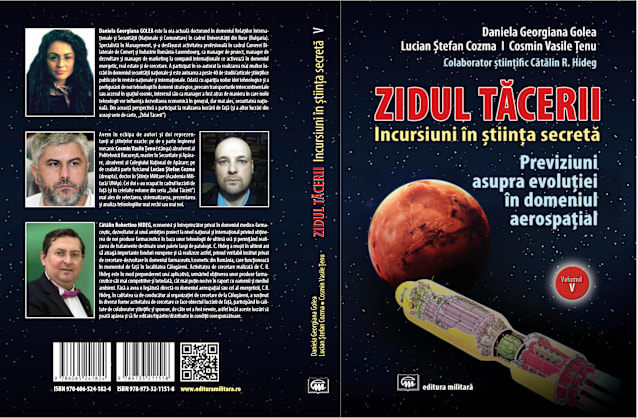Zidul Tacerii - Incursiuni in Stiinta Secreta
About
Volume V: Forecasts on the Evolution of Aerospace Technology
Authors: Daniela Georgiana Golea, Lucian Ștefan Cozma, Cosmin Vasile Tenu
Scientific Collaboration: Catalin R. Hideg
This fifth volume in the Wall of Silence series presents an ambitious and thought-provoking attempt to anticipate the future of aerospace evolution. Drawing on interdisciplinary knowledge and critical inquiry, the authors aim to identify current trends, future breakthroughs, and the potential strategic shifts that may redefine humanity’s access to and presence in outer space.
Through a multidisciplinary lens—integrating political science, national security studies, and aerospace engineering—the book explores both conventional and unconventional technological pathways. Particular attention is paid to the global context in which the space race is no longer driven solely by superpowers, but is increasingly shaped by emerging economies, private stakeholders, and disruptive innovations.
What sets this volume apart is its insistence on examining the real potential of currently marginal or overlooked technologies. The authors argue that future progress may come not only from technological refinement, but also from a conceptual re-evaluation of the principles guiding space exploration. This perspective is reinforced by a historical and strategic understanding of how past decisions have influenced the current trajectory—and how they may limit or enable tomorrow’s possibilities.
With an accessible structure yet rich in technical and analytical content, this volume addresses professionals, policymakers, researchers, and curious minds alike. It continues the broader mission of the Wall of Silence series: to peel back the layers of secrecy, myth, and inertia that often cloud scientific progress and to offer a grounded, critical, and visionary roadmap forward.
Praise for this book
The present volume stands out through its daring approach to a topic often avoided in mainstream aerospace literature: the structural stagnation and conceptual inertia that characterize current human activity in outer space. Unlike typical academic treatments that merely describe the status quo or echo institutional narratives, this book critically re-evaluates the strategic, technological, and even philosophical underpinnings of space exploration.
The authors succeed in highlighting the dissonance between the visionary aspirations of the past and the utilitarian, profit-driven models of the present. Through a multidisciplinary synthesis that bridges national security, unconventional technologies, and economic dynamics, they offer a unique and compelling interpretation of the aerospace field’s current deadlock—and propose that innovation may well lie in re-examining paths long since forgotten.
What makes this work truly relevant is its courage to question official truths and its capacity to reintroduce into the scientific debate technologies, concepts, and historical lessons that have been either neglected or intentionally suppressed. It is a book that not only informs but challenges, inviting the reader to reconsider what we know—and what we assume—about our future in space.
